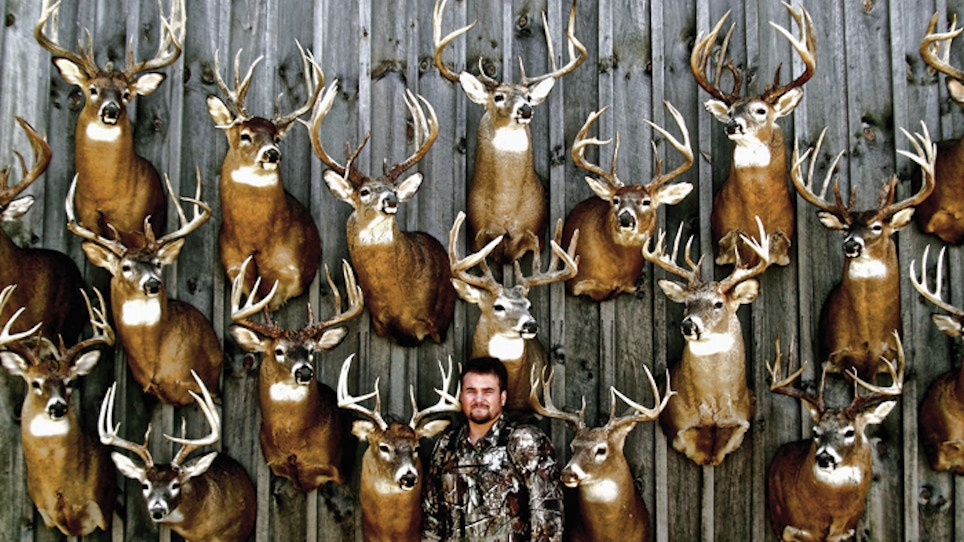Anyone who has chased whitetails for virtually any length of time has wondered if the moon really has an effect on deer movement. Full moon, old moon, new moon, crescent moon or whatever moon – does that cheese ball in the night sky really play a role in the outcome of a hunt? Because of our busy lives and limited time to pursue the most beloved big-game animal in North America, most of us simply give it a passing thought as we head to the treestand. For some, however, the saucer in the night sky can play a crucial role when it comes to finding, patterning and ultimately killing a reclusive whitetail buck, and they have the bone on the wall to show for it.
One of the hosts of the popular outdoor television show Team 200, Adam Hays has been chasing whitetails for over three decades. An Ohio native, Hays started bowhunting at age 14 and killed his first buck with a bow a few years later. He’s been hooked ever since. When he killed his first 200-inch Ohio giant in 1999, something changed in his whitetail psyche. Since that fateful day he’s almost exclusively hunted for the biggest whitetail the ground he hunts can produce.
Hays has over 40 Pope & Young class bucks to his credit. Of those bucks, nine have grossed over the 170-inch Booner mark (196, 182, 185, 178, 173 and 172 inches), and three of those smashed the magical 200-inch threshold (208, 203 and 201 inches). Needless to say, it takes more than a lucky horseshoe and good fortune to kill just a couple of Booners in a lifetime, let alone nine of them. Although he credits several factors for his unmatched success, Hays’ understanding of the moon’s position at specific times and its effect on deer movement has played perhaps the biggest role in his overall success.
Hays readily admits that living and hunting in the Buckeye State, which has a reputation for producing the nation’s top bucks every season, does have its advantages when it comes to targeting and ultimately killing true-blue monsters. However, Hays says it’s not so much killing a Booner as it is killing the most mature buck a hunter has access to. Whether it’s a 200-inch king or a mature 150-inch stud, Hays says understanding the moon’s effect on deer movement in general, and on mature bucks in particular, will play a vital role in your success.
“If I had to name just one thing that has increased my success in seeing monster bucks during the daylight hours, whether it’s in season or during summer scouting,” said Hays, “it would have to be paying attention to the moon.”
As Hays explained it, the moon is directly overhead (straight up) and directly underfoot (straight down) every 24 hours. These “moontimes” are roughly 12 hours apart and happen just short of an hour later every day. It is when the moon is in these positions that the greatest gravitational pull occurs, naturally influencing animal movement.
“Even in the middle of the day, if the moon is in one of these positions, chances are deer movement will increase to some degree,” Hays explained.
In fact, it’s his contention that if you were to check these moontimes when you see deer feeding in the middle of the day or when a buck you’ve only had nighttime pictures of suddenly shows himself during daylight hours, you would find a moon correlation much of the time.
For the bowhunter, the key to capitalizing on these moontimes is focusing on what Hays calls the “Red Days,” which is when the moon is overhead or underfoot during the natural prime early morning or late evening hours. In fact, this has been a factor in every Booner Hays has killed, as well as many of his P&Y candidates. Furthermore, just this past season two of the largest bucks recorded (the Franz 258-inch brute and the Flack 244-inch monster) were killed in Iowa on October 12th and November 10th, respectively. According to Hays, “Both were killed on days where the overhead moon occurred right before daylight and the underfoot moon was within the last two hours of the day.”
It’s not a secret that early morning and late evening hours are naturally the best times to kill a buck, explained Hays, but when you add a corresponding overhead or underfoot moontime during those times, you double your chance that the mature buck you’ve been after will move during daylight hours.
“There are only a handful of days every month that the moon will be either overhead or underfoot during these prime times, and these are by far the best days to catch a big buck on his feet during daylight,” said Hays.
Hays insists another key to consistently killing mature bucks is targeting them well before the season begins. Although he uses dozens of trail cameras in this process, visually finding them is also very important, and he also uses this moon method during preseason summer scouting as well. According to Hays, it doesn’t matter if it’s October or July, big bucks are most likely to move during daylight on “Red Days.”






